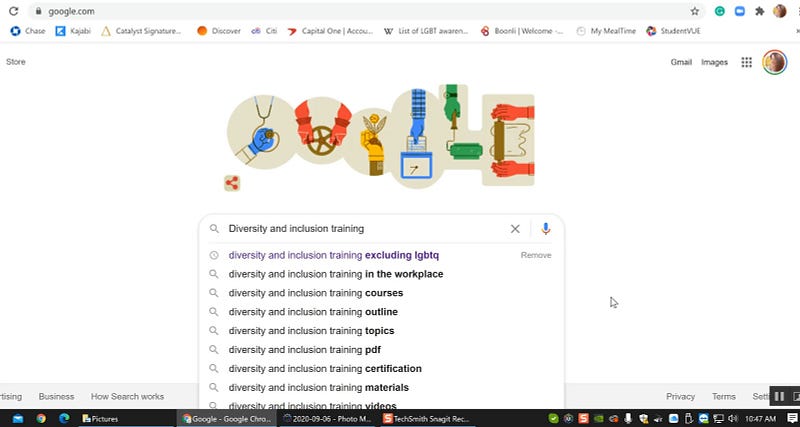How to Spell Inclusion with 3 E's

Years ago, when I was married to my husband, he was a rising star at an infamous “Big 4” accounting firm. He was tapped as a potential partner in the firm and was asked to go to many Human Resource trainings. He was already a great accountant, but his company wanted him also to possess great management skills. I always knew when he’d attended a training, because he’d come home that day ready to practice what he’d learned.
He’d try “active listening techniques” as we got the kids ready for bed, and he’d ask for a “feedback meeting” that night. It made me giggle, but actually I always appreciated it. When he was at work, he was motivated and in the right mindset to learn new skills. His instructors were always top-notch and the skills he learned at work to become a great manager translated into our relationship at home. Even though he was working extra-long hours for clients most of the year, I felt a strong loyalty to his company that invested in his growth. And my husband, similarly, felt like he was cared for and belonged in his company’s culture.
In the aftermath of the racial uprising happening in the United States, there is no shortage of conversation around the importance of diversity and inclusion in the workplace. Many companies know that embracing diversity and inclusion is not only the right thing to do, it’s also the profitable thing to do.
While “diversity” refers to the employees a company attracts and hires, and “inclusion” refers to which of those employees feel like they belong, they both impact the bottom line in a big way. Inclusive companies enjoy 2.3x greater cash flow. 35% of diverse companies outperform homogenous companies,and the Harvard Business Review tells us that diverse companies are 70% more likely to capture new markets.
If your company’s primary approach to improving diversity and inclusion is creating policies and focusing on compliance, you are likely not seeing a return on your investment of time, resources, and energy. Policies do not create culture. Education, experience, and exposure are the most reliable ways to create the culture you seek. And culture is what leads employees to feel valued and empowered. Culture is the difference between wanting to work late to finish a project and skipping out early. Culture is what leads people to engage, to invest, and to innovate. Culture also determines your retention rate. When people feel included, they are more likely to stick around.
An effective diversity and inclusion plan addresses how to create a culture where all employees feel seen, safe, appreciated, and can be their true selves. In order to do this, it’s important for organizations to ensure that employees with marginalized identities feel a sense of belonging. If your organization is like most, it likely does have some awareness training around race and maybe even gender. However, race and gender are just two components of employees’ identities. It’s equally important to address sexual orientation. Until Lesbian, Gay, Bisexual, Transgender, and Queer (LGBTQ) employees’ experiences are demystified and normalized, your LGBTQ employees won’t be able to show up and make the maximum contribution to your workplace that they can.
Discussing LGBTQ issues in the workplace is still the exception rather than the norm. As I conducted research online for this article, I put into Google “diversity and inclusion training …” And, if you look below, you can see what popped up first.

See that first autocomplete option? “Diversity and inclusion training excluding lgbtq.” Wow.
Diversity and inclusion leaders, trainers, and HR managers are pretty sure your company can’t handle having LGBTQ conversations in the workplace, so they are deliberately searching for trainings that exclude it.
“Now wait Elena,” I can hear you saying. “Maybe we won’t gain enough from LGBTQ awareness conversations to make the tension worth it.”
I understand that it can be sticky and uncomfortable to have conversations about sexual orientation. You, and your colleagues, are not eager to willingly walk yourselves into having Michael Scott, cringe-worthy moments. Yet, profit is profit, and if we can increase the bottom line by just investing in conversations, why would we avoid that?

Let’s make the conversation easier and well worth your time. That’s achieved through exposure, education, and experience.
Exposure begins from the minute the facilitator walks through the door. You probably would not hire a white trainer to talk about racism in the workplace or a male trainer to talk about gender discrimination and women’s leadership. Similarly, you want to hire an LGBTQ trainer to lead effective LGBTQ training. Yet, if you are anything like most organizations, conversations about sexual orientation and gender identity are folded into other D&I training and led by trainers who are not members of the LGBTQ community nor experts in this area. More important, it’s quite possible many of your staff only know one or two LGBTQ people and need exposure to LGBTQ leaders — and permission to ask them their awkward questions.
Education. This might sound obvious, for that’s what’s covered in workplace training, right? “Good training” delivered by fancy PowerPoint presentations and engaging handouts is not enough. Education is about giving your staff real-world information that inspires and empowers them to step up and learn more. LGBTQ education has to be delivered in a way where no one feels on the defensive, regardless of what their personal views are.
It is possible to connect with people who possess homophobic views or are uncomfortable with members of the LGBTQ community. It’s tricky, but possible! You want to look for a trainer who not only knows how to engage communities around polarizing topics and create safety and belonging for employees to enter into brave conversations. You also want a trainer skilled in emotional intelligence (EQ) who uses EQ as a frame for LGBTQ training.
Also, you want to ensure that your LGBTQ awareness curriculum covers the following four main points:
- Allows people to ask questions regarding sexual orientation and gender identity
- Covers practical ways to be an ally to members of the LGBTQ community
- Specifically addresses LGBTQ issues in the workplace
- Supports participants to transfer their insights into action (and gets incorporated into workplace culture)
Finally, the last “E” is Experience. Your Diversity, Equity, and Inclusion training should include ample opportunities for case studies and role plays. Let your employees practice their response to a co-worker coming out to them so when it happens in real life, it can lead to a genuine connection, not a meeting with the head of Human Resources. It’s one thing to talk about “what to say.” It’s an entirely different (and important) thing to practice crucial conversations and receive feedback on them.
It is possible that only a small percentage of your employees are LGBTQ. However, these issues affect all of them. How many of your straight employees have LGBTQ children? Siblings? Does your administrative assistant feel comfortable discussing her trans daughter at work? How many of your staff lost LGBTQ friends to suicide when they were growing up?
Sometimes I wonder how life would have turned out differently if my husband had already had LGBTQ training at work when I came out to him. I had been so deep in the closet for so long, I didn’t even have the words beyond “I think I’m a lesbian.” Maybe if he had experienced training like that, he would have had the words to communicate with me and his team at work when we decided to end our marriage. He had no idea how the other partners would react, and it only increased his stress and lowered his productivity.
Safety, Belonging, and Inclusion at work all begin with the Big Three: Education, Exposure, Experience. When we integrate the three into our corporate trainings, we can actually move the needle. And improve the bottom line.
About the author:
Elena Joy Thurston is an inspirational LGBTQ+ speaker, trainer, and founder of the nonprofit Pride and Joy Foundation. A Mormon mom of four who lost her marriage, her church, and her community when she came out as a lesbian, Elena’s viral TEDx talk on surviving conversion therapy has been viewed 45,000+ times and landed her media and speaking opportunities with ABC, CBS, Logitech, Michael’s, and more. Elena Joy recently launched Pride and Joy Publishing, the only publisher of solely LGBTQ+ empowerment and business books.

